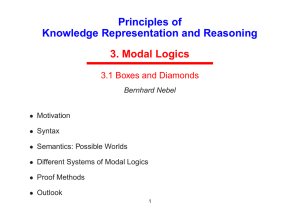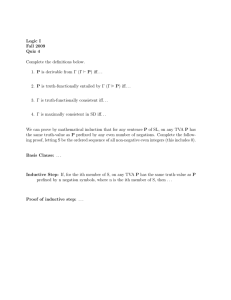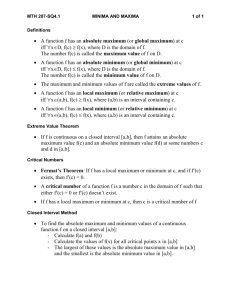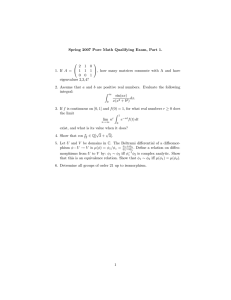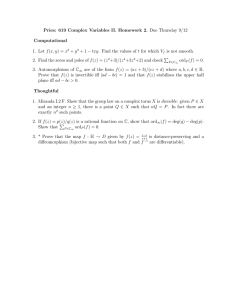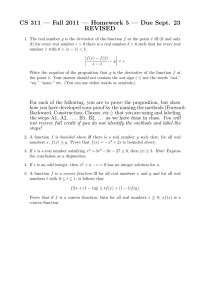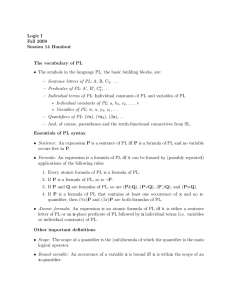Philosophy 244: #8— Counterfactuals, Neighborhood Semantics, Probability, Predicative Necessity, etc.
advertisement
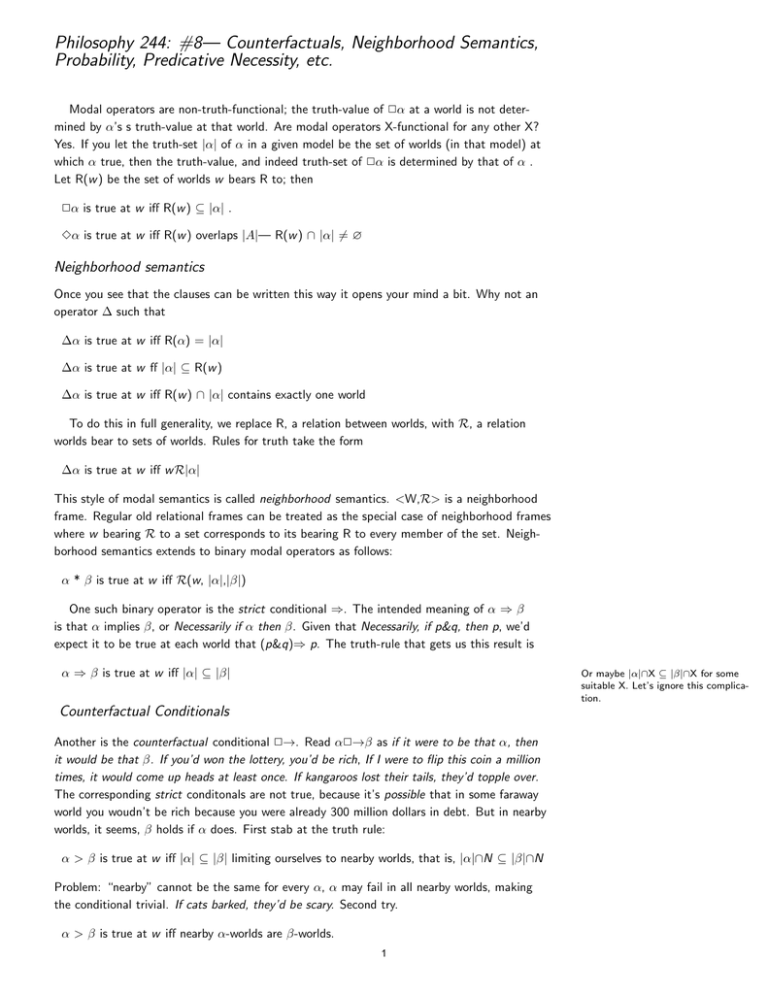
Philosophy 244: #8— Counterfactuals, Neighborhood Semantics, Probability, Predicative Necessity, etc. Modal operators are non-truth-functional; the truth-value of 2α at a world is not determined by α’s s truth-value at that world. Are modal operators X-functional for any other X? Yes. If you let the truth-set |α| of α in a given model be the set of worlds (in that model) at which α true, then the truth-value, and indeed truth-set of 2α is determined by that of α . Let R(w ) be the set of worlds w bears R to; then 2α is true at w iff R(w ) ⊆ |α| . 3α is true at w iff R(w ) overlaps |A|— R(w ) ∩ |α| 6= ∅ .Neighborhood semantics Once you see that the clauses can be written this way it opens your mind a bit. Why not an operator ∆ such that ∆α is true at w iff R(α) = |α| ∆α is true at w ff |α| ⊆ R(w ) ∆α is true at w iff R(w ) ∩ |α| contains exactly one world To do this in full generality, we replace R, a relation between worlds, with R, a relation worlds bear to sets of worlds. Rules for truth take the form ∆α is true at w iff w R|α| This style of modal semantics is called neighborhood semantics. <W,R> is a neighborhood frame. Regular old relational frames can be treated as the special case of neighborhood frames where w bearing R to a set corresponds to its bearing R to every member of the set. Neighborhood semantics extends to binary modal operators as follows: α * β is true at w iff R(w, |α|,|β|) One such binary operator is the strict conditional ⇒. The intended meaning of α ⇒ β is that α implies β, or Necessarily if α then β. Given that Necessarily, if p&q, then p, we’d expect it to be true at each world that (p&q)⇒ p. The truth-rule that gets us this result is α ⇒ β is true at w iff |α| ⊆ |β| Or maybe |α|∩X ⊆ |β|∩X for some suitable X. Let’s ignore this complication. Counterfactual Conditionals Another is the counterfactual conditional 2→. Read α2→β as if it were to be that α, then it would be that β. If you’d won the lottery, you’d be rich, If I were to flip this coin a million times, it would come up heads at least once. If kangaroos lost their tails, they’d topple over. The corresponding strict conditonals are not true, because it’s possible that in some faraway world you woudn’t be rich because you were already 300 million dollars in debt. But in nearby worlds, it seems, β holds if α does. First stab at the truth rule: α > β is true at w iff |α| ⊆ |β| limiting ourselves to nearby worlds, that is, |α|∩N ⊆ |β|∩N Problem: “nearby” cannot be the same for every α, α may fail in all nearby worlds, making the conditional trivial. If cats barked, they’d be scary. Second try. α > β is true at w iff nearby α-worlds are β-worlds. 1 Suppose a coin is flipped and I am offered a chance to bet on the outcome. I decline, but if I had bet, it would have been on heads. I want to say that If I had bet, I would have won, The coin could very easily have come up tails, though; including in nearby worlds where I bet. So there are nearby worlds where I bet but lost. α > β is true at w iff the nearest α-world is a β-world. (Stalnaker) What if there is no nearest |α|-world? If I you were over 5’ tall, you could ride the roiler coaster. There’s no closest way of being over 5’ tall, but still the conditional seems true. Why? Well, you can ride in all close-enough such worlds. Some You’re 5’ tall and can ride the roller coaster -worlds are closer than any You’re 5’ tall and can’t ride it-worlds α > β is true at w iff some u in |α|∩|β| is more like w than any v in |α|∩|β| (Lewis) Assess for validity, using Stalnaker’s truth-conditions: the nearest α-world is a β-world. Modus Ponens: p⊃((p 2→q)⊃q) If Hoover spoke Russian, he’d be bilingual....If she were in France, she wouldn’t be in Paris....If Spain had fought with the Allies or the Axis.... Transitivity: (p 2→ q) ⊃ ((q 2→ r ) ⊃ (p 2 →r )) Contraposition: (p 2→ q) ⊃ (¬q 2 → ¬p) Simplification: ((p∨q) 2→ r ) ⊃ (p 2 →r ) Probabilistic Semantics The standard semantics for classical logic is two-valued: every sentence is evaluated either as true or false. What if we generalized that and allowed sentences to take arbitrary real values between 0 and 1? Of course, you need a philosophical motivation for this. You might be interested in vagueness and an evaluation of 1/2 means that the sentence is midway between being true and false. If you are interested in partial truth, the 1/2 might mean that the sentence can be divided into two parts of which only one is true. Snow is white and expensive is a half-truth in that sense. Or, if you’re interested in probability, the 1/2 signifies that there is half a chance in the speaker’s mind of the sentence being true. The rules can in some cases be given exactly the same form: (we’ll write P for V): P(¬α) = 1 - P(α) But not always ??P(α&β) = min(P(α), P(β))?? Imagine β = ¬α. ??P(α&β) = P(α) × P(β))?? Imagine β = α? P(α&β) = P(α) × P(β)) provided they’re independent; Yes but suppose they aren’t. P(α&β) = P(α | β) × V(β))—YES A Popper function is any binary function P taking pairs of sentences to real numbers between 0 and 1 (inclusive), subject to six conditions The issue of how to probabilistic semantics for classical logic has been studied by Hartry Field in a paper called ”Logic, Meaning, and Conceptual Role.” Here we try to extend the idea to modal logic. Two strategies have been suggested, both employing conditional probabiliity but in quite different ways. The first understands worlds as hypotheses to be conditioned on, and truth in a world as high probability conditional on a hypothesis: 1. P (A|A)=1 2. P(B|A) is not always 1 3. if P(B|A)=1 and P(A|B)=1 then for all C, P(C|A)=P(C|B) 4. P(C&B|A) = P(C|B&A) × P(B|A) P(2α) = 1 iff for all ω P(α|ω) = 1 The second treats the probability functions themselves as worlds. P’ is accessible from P iff P’ is obtainable from P by conditioning on some hypothesis A, that is, for all B and C, P’(C|B) = P(C|B&A). P(2α) is higher or lower depending on the probabilities assigned to α by probability functions P can see. 2 5. P(C&B| A)<P(B|A) 6. P(¬B|A)=1-P(B|A), unless for all C, P(C|A)=1 Monadic probability is P(B) = P(B|T) where T is some fixed tautology. P(2α) = greatest lower bound of P’(α) as P’ ranges over functions accessible from P. P(3β) = the least upper bound of P’(β) as P’ ranges over functions accessible from P. The philosophical interpretation is not so clear to me. Imagine a thinker who’s in a particular epistemic state but can imagine being in various other such states. If P represents the thinker’s actual epistemic state, ”the functions accessible to P represent those ... epistemic states that the agent... would recognize as distinct and intelligible alternatives” that she could reach by conditionalizing. The meaning of 3α is that one can imagine coming to think that α. Of course, the agent could just conditionalize P’ on α to obtain a P” that made α certainly true. The problem is that this is not a possibility that our agent recognizes while in epistemic state P. She is supposedly unable to fill in the details of his thought experiment with sufficient specificity. Her confidence in 3α corresponds the agent’s ability to “fill in, with a sufficient degree of specificity, the details of a thought experiment” wherein it makes sense to believe that α. P(3α) will take an intermediate value if the agent can see her way through to epistemic states in which α is not certainly false but none in which α is certainly true. Multi-Modal Logic The language contains several 2-operators 21 , 22 , etc. They are all defined over the same set of worlds but the accessibility relations are different. A model is <W,R,C> except that R is not a single accessibility relation but a list of them R1 , R2 , etc. Tense logic is one application; 21 means it always will be the case, 22 means it always has been the case; 31 means it will sometime be the case and 32 that it once was the case. R1 is the relation of temporal precedence and R2 the relation of coming after in time. Given that the relations are converses we can really get by with one of them in our truth rules; let it be the later-than relation. V(21 α,w ) = 1 iff V(α, u) =1 for all u later than w (w Ru) V(22 α,w ) = 1 iff V(α, u) =1 for all u earlier than w. (uRw ) Both boxes appear to satisfy K: If it will always be that α ⊃ β, then if it will always be that α, it will always be that β If it always was that α ⊃ β, then if it always was that α, it always was that β What about T?. What about S4 and S5? What about these two hybrid axioms linking the was and will-be operators? (Example adapted from Humphrey Bogart in Casablanca: “We’ll always have Paris.”) TL1 If we have Paris now, then we will always have (had) Paris in the future. p⊃21 32 p. TL2 If we have Paris now, then we were always in the past going to have Paris. p⊃22 31 p. So-called two-dimensionalism in the philosophy of language falls under this heading too. 21 is regular old metaphysical necessity. 22 is something like conceptual or epistemic necessity or a priority. Julius invented the zip is metaphysically contingent but conceptually necessary. Some popular glosses: 21 p is true iff what p actually says had to be true no matter which world had been actual, p p could not have failed to be true Is TL2 correct? Some say not on the theory that the past is fixed, the future open. Should there turn out to be a sea-battle tomorrow, does that make it true now that there will be a sea battle tomorrow? 22 p is true iff p had to expresses some truth or other no matter which world is actual, p p cannot fail to be actually true The combination of these 21 with @ greatly increases the language’s expressive power, we’ll see later. It comes out clearly in quantificational logic. There could have been more stars than there are. Adding 22 in increases it further. 3 You snooze ⊃ You lose You snooze ⊃ You snooze You snooze ⊃ @(You lose) @(You snooze) ⊃ You lose @(You snooze) ⊃ @(You lose) Necessity as a Predicate Can we construct a theory T of predicative necessity? Let’s agree that the theory has to include arithmetic and that the necessity predicate has to satisfy conditions A1-A4, the Montague conditions. [A] is the Godel number of sentence A. 1. T ` N([P])⊃P 2. T ` N([N([P])⊃P]) 3. T ` N([P⊃Q])⊃(N([P]⊃N([Q])) 4. T ` N([P]) if P is a truth of logic or arithmetic Any such theory is bound to be inconsistent, Montague shows. He begins by letting λ be a “fixed point” of the formula ¬N(x, meaning it’s a theorem of arithmetic that λ ≡ ¬N([λ]). All the numbered formulas are meant to be theorems of T. 1. λ ⊃ ¬N([λ]) (theorem of arithmetic) 2. ¬N([λ]) ⊃ λ (theorem of arithmetic) 3. N([λ]) ⊃ λ (A1) 4. (N([λ]) ⊃ λ) ⊃ ((λ ⊃ ¬N([λ])) ⊃ ¬N([λ]) (propositional logic) 5. (λ ⊃ ¬N([λ])) ⊃ ¬N([λ]) (modus ponens 3.4) 6. ¬N([λ]) (modus ponens 1, 5) 7. λ (modus ponens 2, 6) 8. N([λ ⊃ ¬N([λ])]) (1, A4) 9. N([¬N([λ]) ⊃ λ]) (2, A4) 10. N([N([λ]) ⊃ λ]) (A2) 11. N([(N([λ]) ⊃ λ) ⊃ ((λ ⊃ ¬N([λ])) ⊃ ¬N([λ])]) (4, A4) 12. N([λ ⊃ ¬N([λ]) ⊃ ¬N([λ]) (A3 on 10,11) 13. N([¬ N([λ])]) (A3 on 8,12) 14. N([λ]) (A3 on 9, 13) 15. ¬N([λ]) (modus ponens on 1, 7) 16. N([λ]) & ¬N([λ]) (conjunction of14, 15) 17. !!!!!!!!!!!!!!!! Intuitively what’s meant to be going is this. Assume for contradiction that λ is not true. Then what λ expresses is not the case, so λ is necessary. But then λ is true–since everything necessary is true—contradicting our assumption. This concludes the proof that λ is true. The proof is of a purely logical nature; so its conclusion is necessarily true, that is, N([λ]). N([λ]) is the negation of λ though, which was just proven. Contradiction. 4 MIT OpenCourseWare http://ocw.mit.edu 24.244 Modal Logic Spring 2015 For information about citing these materials or our Terms of Use, visit: http://ocw.mit.edu/terms.
